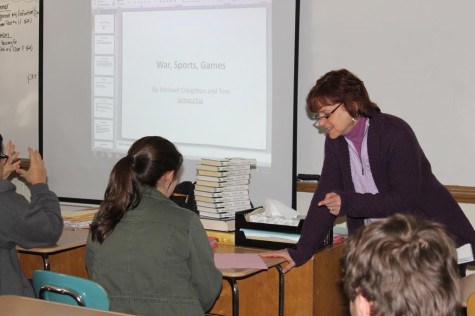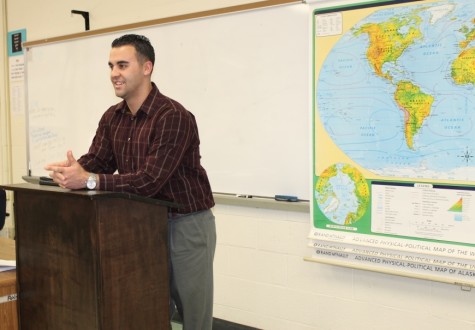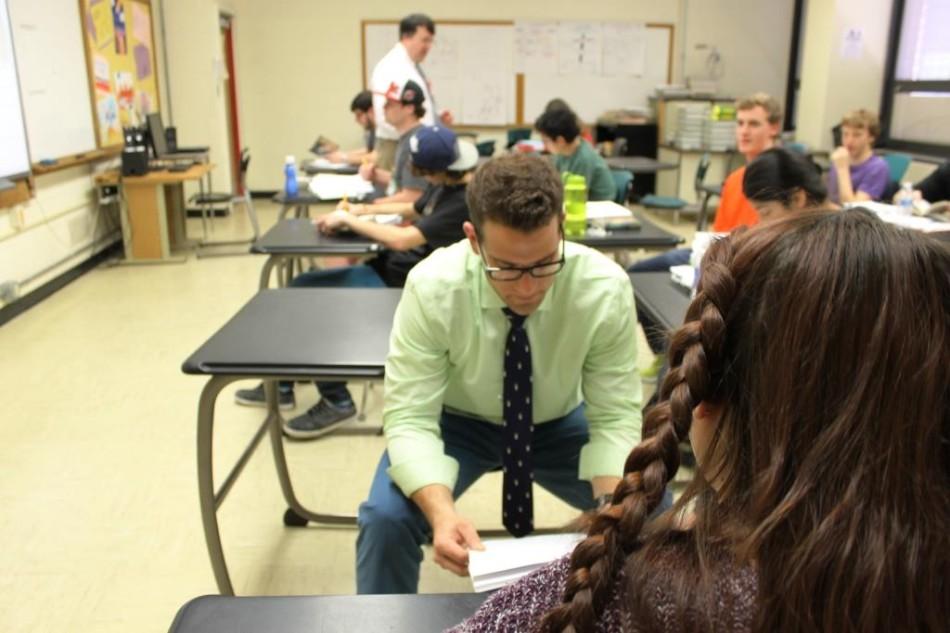Truly special educators
In March, The Glen Echo went inside a special education inclusion classroom. It's what we brought out that matters.
April 3, 2014
Photo Credit: Rebecca Jacobs
Helping a student one-on-one, Mr. McCarten sits to discuss a test. In the background, Mr. Milsovic works with the other half of the class.
Seconds before the bell rings, students begin filing in to talk to their friends before finding their places in the assigned seats. The classroom is noisy and rambunctious, and small talk fills the room.
Beep.
The students, still boisterous, overpower the voice of the teacher calling for the freshman class to take their seats. The worksheets for the day are handed out on blue paper, and the class has finally begun.
As always, there are children who are late, struggling to make it into the classroom undetected with small hints of worry on their faces.
The projector beeps twice, and the algebra problems are displayed on the unwashed white board.
“Does anyone know what the degree of 3x3+4x2-9x-10 is?” the teacher questions. As she anticipates the answer, bewilderment pours over the faces of her class.
She introduces the topic of monomials and polynomials; the sound of pencils scratching across the desks echoes in the silent and tranquil room as students begin to take notes on the subject.
Then, the burly door slams shut with a dramatic bang, and in comes the special education teacher armed with photocopies of notes and worksheets in hand.
She then sits alongside a student, to help clarify the degree of the trinomial on the board. The special education teacher aids in filling-in the notes the student had missed.
The tone of her voice is soft, as to not disturb the rest of the class, but simultaneously optimistic and reassuring.
After helping the first student, she takes down the notes and questions on the board alongside the rest of the class.
No sooner does she sit down when she is forced to get back up to try to maintain students’ focus and encourage them to take notes on their own.
“The eventual goal, believe it or not, is to gradually pull away the support so students can function on their own, and I think sometimes that’s overlooked,” says Joseph McCarten, another special education teacher who works at Glen Rock High School.
McCarten was indecisive when it came to choosing a career. He originally started as a pre-med student at Rutgers University, but then he later transferred to business, following in the footsteps of his father.
“[My father] was a stock broker on Wall Street for many years, and I realized the stress that he dealt with on a daily basis was not something I wanted. So I changed to what my mother’s career is, a special education teacher for fifteen years now,” says McCarten.
He graduated in 2011 with an undergraduate in psychology and a Master’s degree in education.
Almost immediately, McCarten found a job after applying to two or three schools. During the time he was interviewing, there was high-demand for special education teachers.
Recently, however, finding a job in that field has been increasingly difficult. Many of the cohort he graduated with had a tough time finding a job after college, which is primarily why he considers himself very fortunate to be hired here.
Different paths to the same place
The class, once again, begins to get vociferous, and the teacher becalms the students, quieting the irrelevant topics that are flying around.
“Everybody sit down and pay attention to what is on the board!” the special education teacher says above the noise of the students, in attempt to redirect the attention towards the lesson.
The door opens again.
Walking in is another student coming from a guidance meeting. It is the job of the special education teacher to hand the student the missing notes, and the teacher will then try to briefly fill them in on the information that they missed.
“Modifying tests, providing notes, breaking things down, breaking tasks down, providing one-on-one instruction when needed, it’s different in each class,” William Crispino says, reflecting on what exactly his job entails.
Yet Crispino’s motivation was different than McCarten; he was pushed by his basketball coach, not his parents.
“He pulled me aside one day at practice and said that he thought I should go this route. And so what I did was get involved in the Special Olympics and totally fell in love with it. I declared as a freshman in college that I would be a special education teacher,” Crispino says.
Over the years, Crispino and McCarten have paid it forward, inspiring their own students as well.
“Mr. Crispino and Mr. McCarten have been great mentors to me on the sport’s field and in the classroom. I never thought about becoming a learning strategies teacher until I had McCarten and Crispino as my teachers,” says a student in special education classes.
During his studies, Crispino went above and beyond the requirements, graduating with three distinct majors in history, elementary education, and special education.
Throughout college, Crispino faced many challenges mostly related to his triple major. Majoring in different types of education entails an astronomical amount of time in the classroom. He traveled for field experiences in schools all over New Jersey: including Paterson, Lodi, Angelwood, and Passaic.
“Trying to find time to get to all those schools and to fulfill my requirement was a huge challenge, but it was a challenge I was willing to face,” Crispino says.
To be eligible to teach special education, teachers need a Bachelor’s degree in a core subject (such as math, science, history, etc.), and they must fulfill the special education course’s requirements (which is around 45 credits worth) in order to obtain a state-issued certification or license.
“[It] was a program that was designed to include courses involving system of technology, testing, and things like that,” Crispino reflects, “so there was a lot of schooling that [was] involved with it.”
Right after graduating college, much like McCarten, Cripsino was able to begin working. In fact, teacher Joseph Sutera called him regarding an open position here at GRHS. Crispino submitted his resume and interviewed and, within three days, he was hired.
“There is a [higher] demand for male [special education teachers], especially in high school because they want males to be able to coach and teach at the same time to help with possible behavioral problems,” Crispino says.
Many of Crispino’s students appreciate his work both on and off the field.
“Mr. Crispino has helped me in my studies and my personal life. He’s challenging but is a great coach and an even better person,” his student says.
A little history from the Bronx
She stands cautiously over a student as he takes notes and helps fill in the missing pieces of the puzzle.

The algebra teacher shuffles out of the classroom to make copies that have been pushed to the bottom of her massive bag, leaving the special education teacher in complete control of the class.
“I enjoy working with other people, I like bouncing ideas off of other people and having them bounce ideas off of me; two heads are better than one,” says Rochelle Forstot.
Forstot attended University of Massachusetts in Amherst and began with a major in business. After realizing that this wasn’t the path she was destined to take, she switched to history while simultaneously working on her teaching certificate. She graduated with an education and history Master’s degree.
After college, Forstot was sent to interview at different schools in the Bronx by her father, who was a principal. She found a job at Leighman High School through connections with the assistant principal. Although there were no history positions available, she was offered and accepted a job as a special education teacher. She then went back to school and finished with a Master’s degree in special education
“My assistant principal when I worked in the Bronx was very instrumental in guiding me. She was my first supervisor and really helped me along and it really just felt right, opposed to being a history teacher,” Forstot says.
Unique students, unique needs
The special education teacher continues to do problems on the board and displays different ways of solving the problems.
After the algebra teacher returns, the special education teacher walks around the classroom, handing notes to some students and guiding others through various problems.
“Each case is definitely individual. Some students require a lot of attention some require little attention. Some have different disabilities that require different forms of modifications, from testing modification to everyday school modification. So each case is based on the individual,” Crispino says.
Every special education student is given an IEP (individualized education program) with which the students are enrolled into the special education program.
According to the National Center for Learning Disabilities (NCLD) an IEP is created to help teachers, parents, and other school administrators to work together to provide the best education for the student.
To create an IEP, a team will evaluate the student based on classroom test results, individual tests to determine the student’s eligibility, and observations from other teachers and family members.
According to the NCLD, “By law, the IEP must include certain information about the child and the educational program designed to meet his or her unique needs. This information covers topics such as current performance, annual goals, special education and related services, accommodations, participation in state and district-wide tests, needed transition services and measured progress.”
“There are different types of disabilities and we work [in] different ways to meet their goals,” Forstot says.
Due to their IEPs and personal observations by the special education teachers, the workload and tests are appropriate for the individual students.
“One of my philosophies, being a freshmen teacher, obviously we have the IEP given to us and it has the student’s history in there,” says Crispino. “I like to see for myself what the student can do before I start to implement some modifications. I like to give each kid a clean slate, see where they’re at, see what they can do, see what they need help with, and then I go from there.”
Behind the scenes
There are many aspects of a special education position that the average person is not aware of. For example, the excruciating paperwork that special education teachers are required to fill out.
“We have to write IEPs, we have to do progress reports: every time a report card goes out we have to do a progress report updating the parents on how the student is doing,” says Crispino.
They also face the challenge of meeting all of the students’ IEPs and legal ramifications.
“It puts a lot of pressure on us to implement the IEP (individualized education program) to follow that is a challenge. But that’s probably the biggest thing making sure you have your bases covered and students are getting as much as they can aid-wise,” says McCarten.
And of course, there is the time element, trying to meet with teachers of all different subjects and students in all different grades.
“I often just grab [teachers] when I can, having impromptu conversations with them or trying to catch up with what is happening in a class or to find out what’s going on with a particular student,” says Forstot.
Two is better than one
The two teachers resume class, doing problems harmoniously, seemingly solving each other’s equations.
Papers shuffling and footsteps around the room are the only sound heard as they continue working together to assign homework and hand out worksheets before the class ends.

“The biggest challenge is each year having a different co-teacher; you have to start from scratch. If you are lucky enough to be with the same teacher more than once you have a routine and you share materials. It depends on the teacher you’re teaching with, but it’s definitely got its rewards. It’s an extra set of eyes, and it’s great to have a coworkers to bounce ideas off of,” Crispino says.
Jason Toncic, an English teacher at GRHS, has worked with special education teachers in his classroom.
“I always think that it is great to have at least two teachers in a classroom. One teacher can’t see everything and can’t help everyone simultaneously, so it’s always a benefit to have someone else in the room who is educated in teaching practices,” Toncic says.
Students who are in special education classes tend to agree.
One special education student says, “I like it because, as a special education student, it definitely helps when the main teacher is busy and there’s another teacher there to help out. Not only me, but everyone in the class.”
Ask not for whom the bell tolls
Beep.
The bell signals the end of the class and all of the students instantaneously get up and quickly leave. However, at some point in their lives, the familiar sound of the school bell will go off once last time, and then the graduating students will not be returning the next fall.
College is always on the minds of all students.
To help prepare for this monumental step into adulthood, special education students have been given many tools, such as learning strategies. Learning strategies help to develop organizational skills, study skills, and involve pre and post teaching.
“’I’m still nervous because I know learning strategies won’t be there in college, but I feel it has helped me become a better student,” says a special education student.
As the school year progresses and by the exit IEP meeting, the end goal for the student becomes more clear.
“By the time they’re a senior they pretty much know what their direction is going to be – whether they’re on an academic path or [a] life skills path that prepares them to contribute to the work force. It’s not for everyone, even students who aren’t special education. College isn’t for everyone, so it is decided as a student progress where they’re headed,” McCarten says.
If the special education students choose to enroll in college, there isn’t as much support on campus as Glen Rock High School offers to its students. This is why the program is designed for the students to become more and more independent as they become upper classmen.
“My goal as a special education teacher is to have the students’ IEPs shrink as they get older. So what that means is reduce the amount of modifications they’ll need as far as testing so by the time they get to college they need little or no support. Because when they go to college, most don’t offer a lot of services so that students will be on their own anyway. So we have to prepare them for that, to become more individual,” McCarten says.
The stigma of special education?
“I feel that the stigma towards kids in learning strategies is not as bad as it used to be. Although it’s not as bad, I feel that you still catch heat for being in special education,” says a special education student here at Glen Rock High School.
Some students claim that it is only natural to feel as if the modifications are unfair or unjustifiable.
“I don’t think that it’s unfair because some kids do need some help because they don’t learn as well as other kids,” says a special education student, “and when kids that are not in special education program talk about how easy it is, they don’t understand how hard it is to live with something like ADHD. Sometimes I joke about it as an escape route to seem like I’m just one of the normal kids.”
Many of the teachers have observed similar behavior and treatment in special education students.
However, some teachers see a very different stigma.
“I hope a lot of students who aren’t necessarily mine, so general education students, will rely heavily on me. I want that to be the biggest thing,” Crispino says. “I’m not just here for my special education students; I’m here for everybody. I think that’s the biggest stigma that I’m here only for certain kids, and that’s totally not the case.”

William Crispino • Apr 4, 2014 at 10:41 am
Great Job on the article! The way this article is written, it clearly shows how much time and effort was put into gathering the information from a variety of sources. I really appreciate the fact that you gave special education a voice and illustrated how important it is! Thank you so much for including me in it!
Mr. McCarten • Apr 3, 2014 at 10:52 am
This is very well written. I appreciate this article, in that it shows what our job as Special Education teachers is truly about. Thank you for the time spent and the kind words.